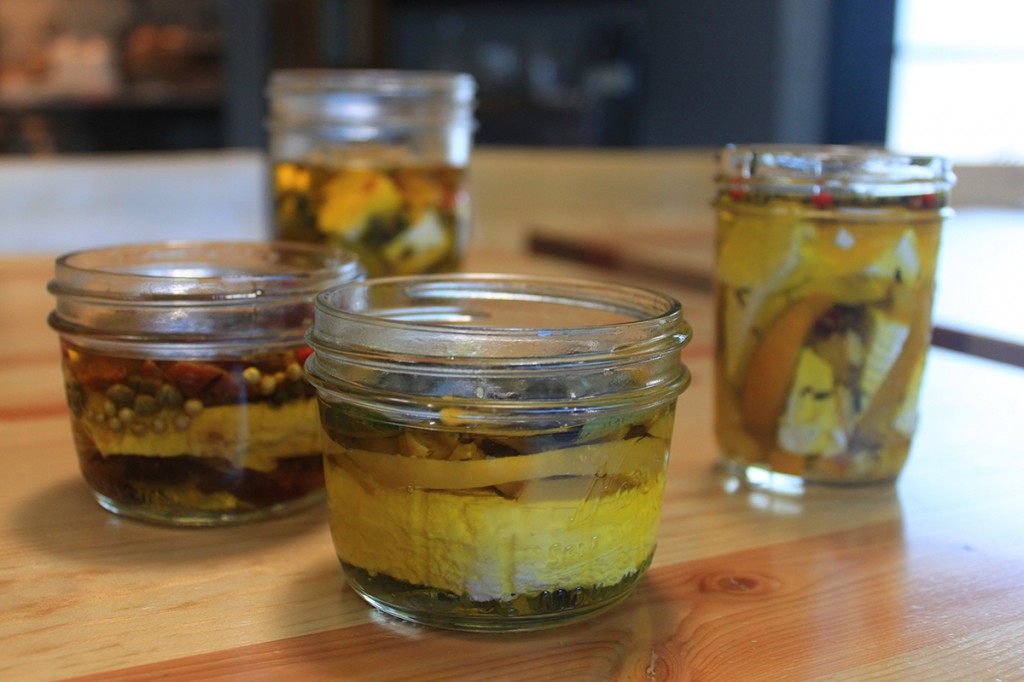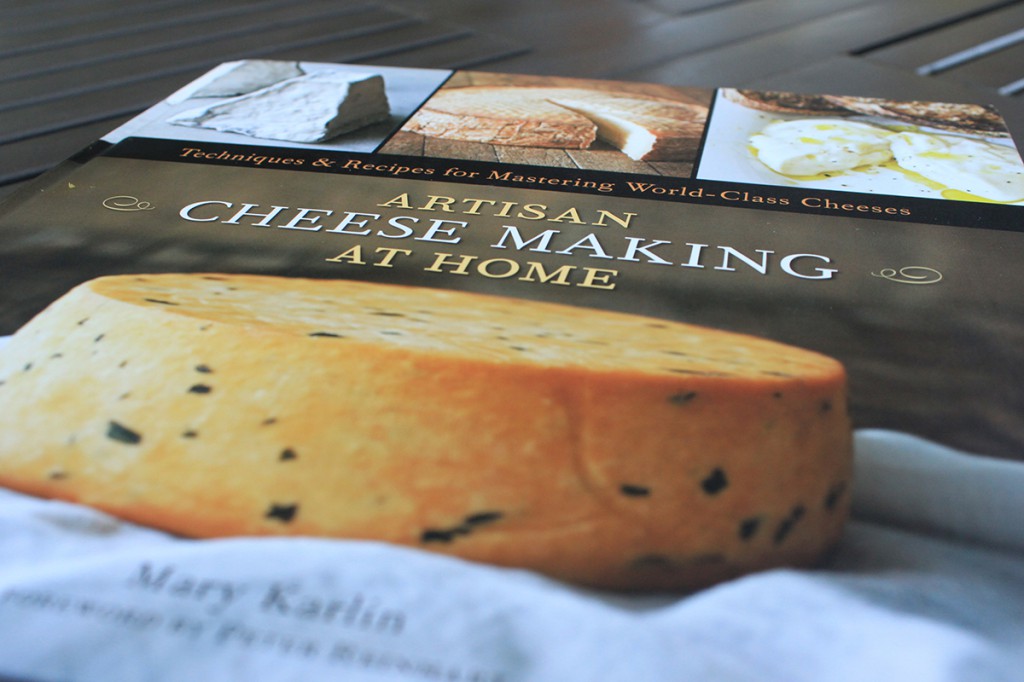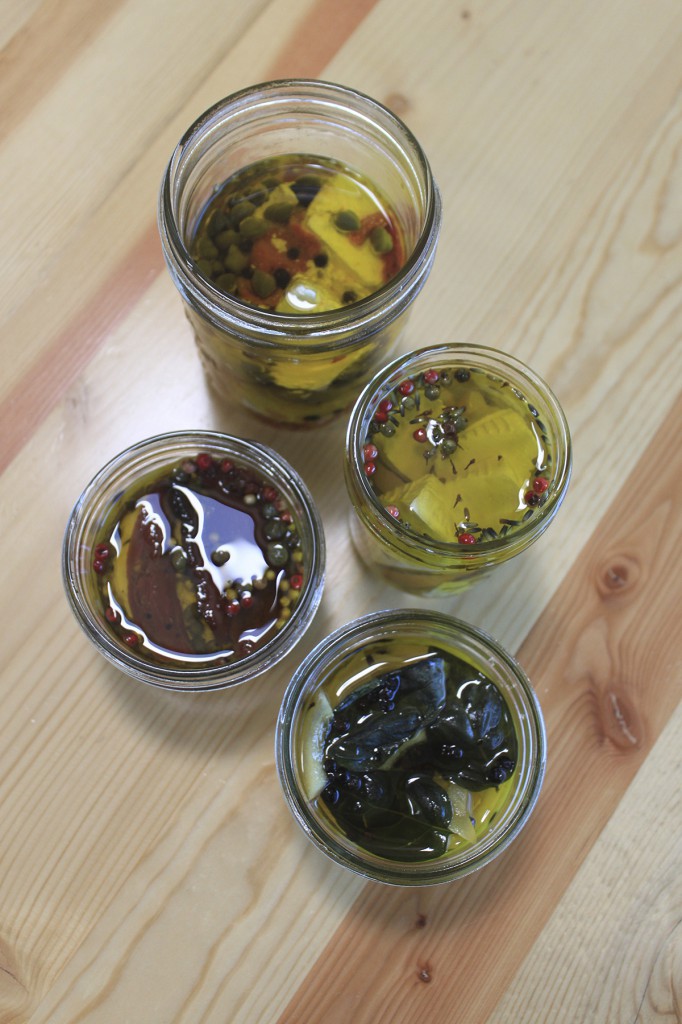When I first cracked the pages of Artisan Cheese Making at Home by Mary Karlin, I knew I was a goner. Not only do I love cheese (so much I married a cheesehead) but the photos in this book are 100% drool worthy. Making cheese can be a bit of an endeavor though so I’m glad that I have my team of girlfriends to collaborate with along the way in our little cheese club, also known as the Culture Club.
We’d started with some of the easier cheeses: ricotta, mozzarella, goat cheese and burrata. We were ready. We were confident. We were ready to try something more complicated and with that motivation we chose cabécou, which means “little goat” in French. While this recipe calls for peppercorns and bay leaves, there’s lots of room to get creative here. We layered in preserved lemons and lavender, roasted red peppers and olives, basil and capers. All were wonderful. And the olive oil soaks up all this goodness, making it perfect to whisk into a salad dressing or to sop up with a hunk of warm bread.
This has definitely been the fan favorite so far and I’m thinking a few special people might find themselves with a jar of this come holiday time.
- 2 quarts goat milk
- ¼ tsp. powdered mesophilic starter culture (MA 011 or C20G)
- 1 drop liquid rennet diluted in 5 Tbsp cool, nonclorinated water
- 2 tsp. kosher salt
- 1 Tbsp herbs de Provence
- 2 tsp whole mixed peppercorns (black, white, pink, green)
- 4 bay leaves
- 4 cup fruity extra virgin olive oil
- Assemble a water bath using a nonreactive 4-qt stockpot set inside a larger pot. Pour water into the larger pot to come halfway up the side of the smaller pot. Remove the smaller pot and place the pot of water over low heat. When the water reaches 85°F, put the smaller pot back in the water to warm slightly, then pour the milk into the smaller pot. Gently mix the milk with a whisk using an up-and-downmotion for 20 strokes to evenly distribute the heat. Cover and slowly warm the milk to 75°F over the course of about 10 minutes, lower the heat, adding cool water to the water bath, or removing from the heat if the temperature is rising too quickly.
- When the milk is at temperature, remove it from the heat. Sprinkle the starter over the milk and let it rehydrate for 5 minutes. Using a whisk, stir the starter into the milk to incorporate, using an up-and-down motion for 20 strokes. Add the diluted rennet to the milk, whisking with an up-and-down motion for 20 strokes to incorporate.
- Cover and allow the milk to set at 72°F for 18 hours, until it coagulates. During maturation, do not touch or move the milk. The curds will form a solid mass during this period.
- Set 4 crottin molds on a draining rack set over a tray and, using a ladle or skimmer, scoop the curds into the molds. When the molds are full, cover the rack with a kitchen towel or lid and let drain at room temperature.
- After 2 days of draining, the cheese will have sunk down to about 1" in height. Unmold them; they should be firm enough o maintain their shape. Salt the cheeses on both sides and dry them in the lower portion of the refrigerator for 2 days on mesh cheese mats (or we used wire cooling racks), turning once a day. Keep them uncovered, as they need to air-dry until the surface is dry to the touch.
- Place each disk of cheese in a sterilized glass jar. Divide the herbs de Provence, peppercorns, and bay leaves among the jars and cover the cheese with olive oil. Close the lids tightly. The olive oil will preserve the cheese, add its own flavor, and carry the flavor of the herbs. Note: the olive oil will solidify in the refrigerator but will return to liquid at room temperature. Age for 1 week to let the flavor develop. Use within 3 weeks.



